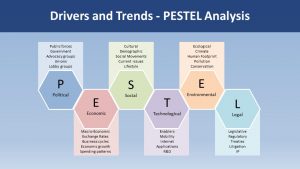2 PESTEL and Micro-Macro: The Story of Trends
PESTEL and Micro-Macro: The Story of Trends

Understanding the Environment
One of the essential pieces of understanding what is happening around you is to notice changes that are signals of trends both large and small.
This TrendWatcher1 activity will help you be aware of trends and changes in your operating environment. At the end of this section we will help you to make sense of the trends that you notice and perhaps identify ways that you can benefit from that understanding.
Trends come in all shapes and sizes. There are the small things that seem to shake and move and then those things that seem to feel like a whole ground shift that leaves us in a new space altogether. We categorise these into micro trends, the small things; and macro trends, those ground shifts that move us into a new space. We will get you to put these together to create a trend analysis that will really help you with your understanding of the environment around you.


Let’s begin with some definitions and explanations.
The word ‘trend’ is used continually in reports, newspapers, strategy analysis, and strategic plans. The thinking seems to be that everyone knows what we mean when we say ‘trends’. It is unlikely that everyone and every organisation has exactly the same meaning in mind. However, we are probably a little more clear when we think about trend analysis: that it is a process that observes specific changes or developments and considers the general direction in which they will affect society more generally and people and entities more specifically.2, 3
The purpose of trend analysis is to stimulate discussion around what we think the significant trends are that will potentially impact us and then try to figure out how they will affect us and in what way they will.
For exmaple, The Austrlaian Army relies hugely on its grasp of trends and their implications. It is necessary to have as much clarity around them and the implications as we possibly can.

For this exercise we define a ‘trend’ as an ongoing, discernible and observable variable that progresses over time, that may or may not impact other factors and variables around it but exists in the context within which an organisation operates.4
Now that is very formal and sounds a bit like ‘jargon’. What it is saying is that we typically can notice and measure them. A trend can change over time and its effects can also change over time. It is also saying that trends can have an impact on each other. All these interactions are happening in and around you and your organisation as well as in other contexts.
We want to break up the definition a little more and help you to categorise trends and develop some insights about their meaning and impact.
Macro Trend
A ‘macro-trend’ is defined here as a trend that is enduring, significant, potentially impacting multiple elements of society, business, military and political environments. Over time macro-trends are acknowledged as potential or explicit major forces for change.
For example:
A macro-trend certainly is that there is a strong focus among many people to be more conscious of health, fitness and careful eating.
Macro Trend
A micro-trend that links to this macro-trend is the advent of ready-made meal kits that can be purchased or are delivered to your home.
Read
Please read this article in The Cove, by Ryan Kelly. The article raises big questions and prompts you to think about the future.
Think
Using the definitions of macro-trends and micro-trends, make a list of what you can identify from the article as the macro-trends and the micro-trends.
When you have completed the list, spend some time thinking about the implications of those trends. What do they mean for the bigger picture and also your more immediate environment?
You can download the Macro-Micro Trend Analysis template below to help you do this.
Now you have completed this Macro-Micro analysis, here are some more thoughts. Benjamin Schneider and his teams have worked for many years exploring what organisational members, including soldiers, ‘know’ about their organisations, compared with what their leaders think they ‘know’.5 Overall, the inference is that organisational members in most situations know a lot!
One of the things for you to take out of this exercise is that you might know a lot about the micro-trends and their impact on ‘what’s going on around you’.
Before we finish
To wrap up this part of the exercise, please go back over your macro and micro-trend analysis and the implications you have noted. Pull all of those insights together.
If you were to share with someone, what would you be saying! What have you learned about the landscape you are in?

© Commonwealth of Australia 2020

